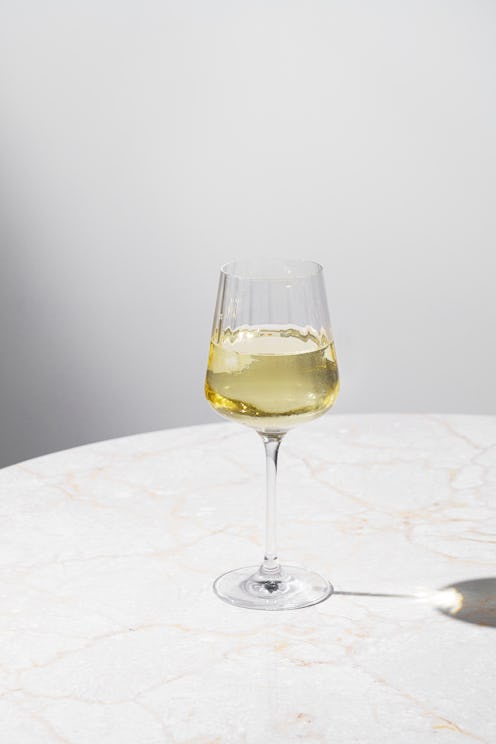(Entertaining)
Chardonnay Is The Perennial White Wine For Your Fall Festivities
Anything but basic.

Move over PSL, Chardonnay is here to usher in the fall. It may not seem like the obvious beverage to bring on the cool weather, but this crisp drink is a surprisingly perfect match for colder days ahead. Over the years, Chardonnay has unfairly gotten a bad rep in mainstream wine culture. It is often dismissed, relegated to table wine, and doesn’t always carry the prestige of other white varietals. But true wine enthusiasts know better, and things are looking good for the future of Chardonnay. In fact, over the next 10 years, the expected market value of the category is supposed to increase by $500 million dollars at a CAGR of 7%. That’s impressive.
Since most people’s knowledge of Chardonnay is limited to a stereotypical buttery white wine, we’ve enlisted some experts to explain its complexities, PR problem, and why it’s on track for a renaissance. Kurtis Ogasawara, director of winemaking at Robert Mondavi Winery says Chardonnay has been anything but generic since its inception. “For centuries, people have been making make Chardonnays that show great intensity and personality,” he explains. “They feature high-quality grapes that express their terroir and age ability.”
But Ogasawara also understands where the varietal’s negative perception comes from. He says, the root of the issue is actually in its booming popularity and everyone wanting a piece of the action. “More and more producers planted Chardonnay across the globe,” he says. “Although it’s able to be grown in both warm and cool climates, it’s a wine that truly reflects where it's grown.”
Just because the grape can grow in various climates doesn’t mean the final product will be similar. “This results in some Chardonnays that lack personality and are less interesting,” Ogasawara shares. These lower quality versions of the wine (often dubbed “table wine”) don’t have the same purity of fruit, acidity, and balanced palate which turn off many consumers, he says.
The biggest factor that differentiates a great Chardonnay from a table wine is the vineyard. “The best Chardonnays come from special sites where winemakers can show the perfect combination of fruit intensity, texture, weight, elegance, and freshness,” he notes. “That’s done by picking the grapes at the optimal flavor profile and acidity and ensuring we select barrels that highlight the fruit instead of holding it down. Battonage during barrel aging is crucial in adding creaminess and mouthfeel to balance out the fresh acidity we find in our Chardonnay.”
Michael Accurso, winemaker for Post & Beam Winery (part of the Far Niente Wine Estates), agrees that the vineyard is integral for a successful Chardonnay. “The best way to let Chardonnay shine is through acidity,” he says. “The Carneros area and the cool climate allow for amazing acid retention and ultimately a lively and expressive wine. With ideal midday and afternoon temperatures, the ripening of Chardonnay is never a concern.”
With Chardonnay on track to continue its rise in popularity over the next decade, one has to wonder what this means for innovations in the category and varietals. “The overall winemaking process has not changed in thousands of years but the tools used have,” Ogasawara says. He’s particularly excited to get new presses at Robert Mondavi Winery, which are a crucial element in white winemaking. “The new presses have smarter programming that will enable us to have greater control and precision at the press,” he explains. “This will help to ensure we get the highest quality juice from the grapes which directly translates into the glass.”
Accurso is less concerned with innovation and is focused on maintaining the taste and quality of Post & Beam’s style that their customers have come to enjoy. “Where we source and how we farm will help us deliver the desired wine style focusing on brightness and zesty acid structure,” he says. “In the winery, we want the fruit to shine and the oak to elevate it; not the other way around.”
Chardonnay Rules Of Thumb
It’s easy to understand what differentiates a great Chardonnay from a bottle of table wine in theory but putting that knowledge into practice at the store can be a bit confusing. Our experts are armed with tips to make the shopping experience seamless. For an excellent bottle of Chardonnay, Ogasawara recommends “choosing one that has the sub-region, or a single vineyard noted [on the label] as that is a solid indicator of quality and sense of place.”
Accurso encourages new Chardonnay wine drinkers to experiment by trying bottles from different regions. “Some of my favorites are Carneros, Sonoma Coast, and Oregon,” he says. “Then, when you zero in on a style you prefer, look for those descriptions on back labels or from reviewers you trust.”
When it comes to the question of price point and how it is reflective of quality, the experts have different opinions. Accurso doesn’t believe it’s a hard and fast rule. “If a person likes the wine, then it’s a good wine,” he says. He also mentions that there are a variety of other factors that configure the actual price of the wine like the price of the grapes, the oak barrel program, and how long it is in the barrel.
For Ogasawara, the price is reflective of the quality and location of the grapes sourced for that bottle. “For example, our Napa Valley Chardonnay costs $35, with grapes sourced across the region, blending multiple AVAs,” he says. “Our Estates Chardonnay is priced at $60, with grapes sourced from Carneros, providing freshness and elegance on the palate.”
Most of all, Ogasawara doesn’t want one bad Chardonnay experience to taint the opinion of the varietal or prevent people from trying it from other producers. “You may find the producer that you enjoy and change your mind on what Chardonnay can taste like,” he suggests.
Ahead, a curated collection of expert-approved Chardonnays for wine connoisseurs and casual drinkers to enjoy equally.